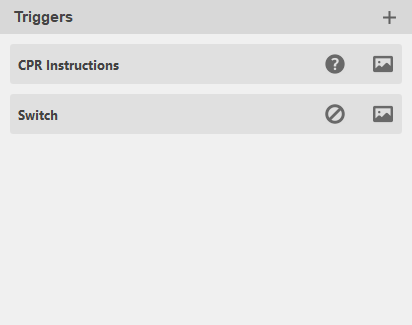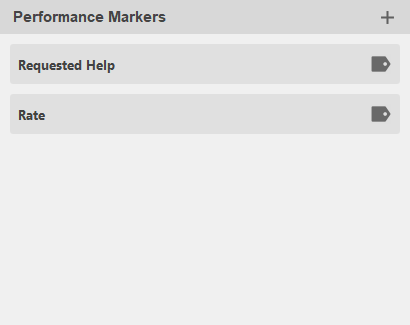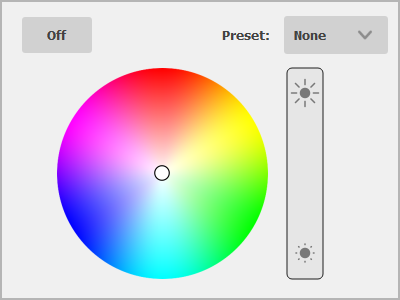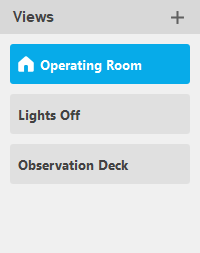Edit Scenes
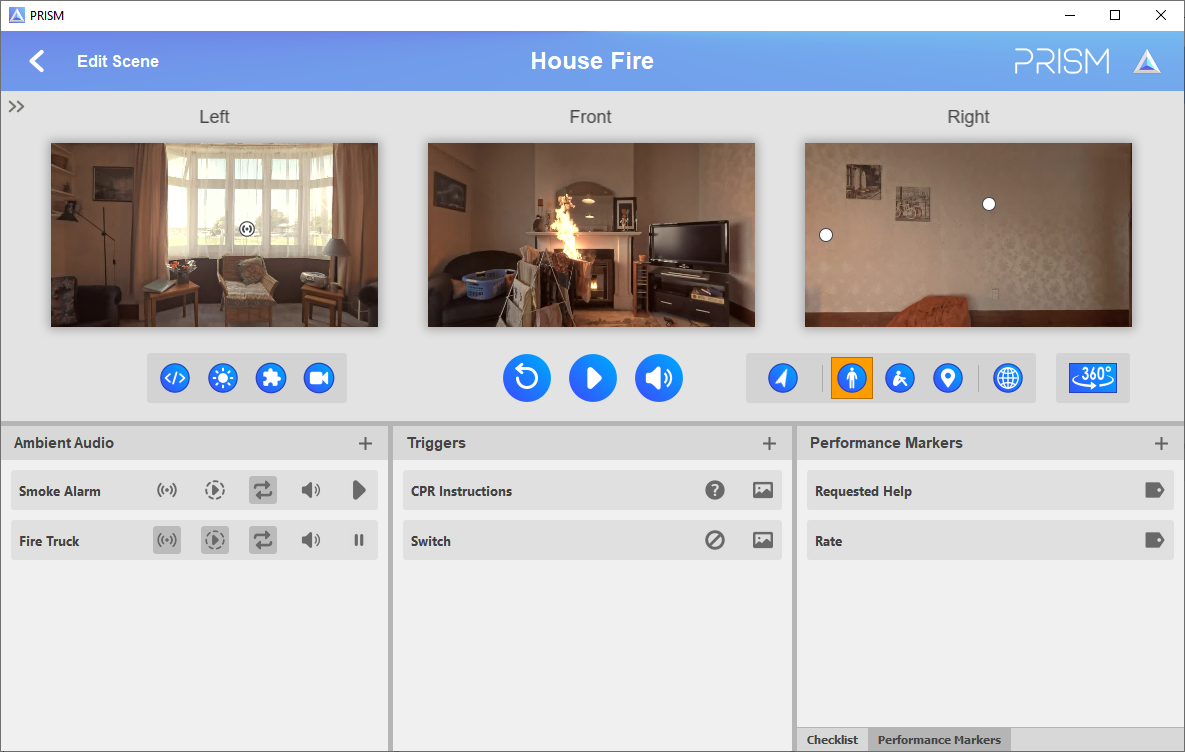
To edit a scene, right-click the scene thumbnail within the scene browser and select Edit. If the scene exists on the server it will need to be synced locally before editing can begin. Syncing can take a few minutes if the scene contains large assets that don’t exist yet on the local machine. To finish and save your edits, click the back button in the navigation bar to go back to the scene browser.
Name
To rename the scene, click on the current name in the navigation bar at the top of the window, enter the new name, and press return.
Video
The main video panel displays the scene video along with controls on how to display the video. The video is split up based on the current projector configuration, which provides an accurate preview of how the video will look within the PRISM theater. Below the video are the following controls:
-
Metadata: Displays popup to edit the scene description and tag list. The metadata is used when searching for scenes in the scene browser.
-
Lighting: Displays popup to change the scene lighting
-
Addons: Displays popup to add/remove scene addons.
-
Main Video: Displays popup to edit the main video settings. You can change the main video. Toggle whether the main video should loop. Change the volume of the main video (this will not affect the volume of any ambient audio or trigger media).
-
Restart: Restart the main video from the beginning. This will also stop all ambient audio and restart “auto-play” items.
-
Play/Pause: Toggle playing of main video and ambient audio.
-
Mute: Toggle muting of main video and ambient audio.
-
360 View Direction: For 360 videos, this controls the direction of the view. Click and drag the compass left/right to change the direction.
-
360 Standing View: For 360 videos, this setting will optimize the view for a person standing in the center of the PRISM theater.
-
360 Seated View: For 360 videos, this setting will optimize the view for a person seated in the center of the PRISM theater.
-
360 Custom View: For 360 videos, this setting will display a popup to customize where the optimal view location will be within the PRISM theater.
-
360 Format: For 360 videos, this setting will display a popup to select the format of the 360 video. You can choose between equirectanguar format and equiangular cubemap format.
-
Display Mode: Change the video display mode to one of the following:
-
360 Display Mode: Display the video as a full 360 spherical video.
- Fill Display Mode: Fill the entire display with the 2D video. Depending on the aspect ratio of the video and display, either the top/bottom or left/right edges of the video will be cropped.
- Fit Display Mode: Fit the entire 2D video within the display. Depending on the aspect ratio of the video and display, either the top/bottom or left/right edges of the display will be empty.
Ambient Audio
The Ambient Audio panel allows adding audio that will play along with the main video, but can be individually controlled.
To add ambient audio, you can drag/drop any supported audio file into the Ambient Audio panel. Alternatively, you can click the + button in the panel title bar to select from existing audio assets. Video files with audio tracks can also be used as ambient audio, however the video will not be displayed.
The following settings are available for each ambient audio clip added:
-
Spatialize: If enabled, the audio will be spatialized to simulate that it is coming from a specific direction. When enabled, an overlay will appear on the video that represents the location within the video that the audio should be emitted from. You can click and drag on the overlay to change the location.
-
Auto-Play: If enabled, the audio will automatically start playing when the scene starts. If disabled, the audio must be played manually by the instructor.
-
Loop: Controls whether the audio plays once or loops indefinitely.
-
Volume: Adjusts the volume of the audio.
-
Play/Pause: Toggle playing of the audio within the editor.
Note
Clicking play on an ambient audio clip will not play if the main video is paused. When the main video is unpaused, the ambient audio will automatically resume playing.
Right-click on an ambient audio clip to perform the following actions:
- Rename: Change the display name of the ambient audio clip.
- Delete: Delete the ambient audio clip.
Triggers
The Triggers panel allows adding trigger actions to the scene. These actions can display media, play audio, and more. Triggers can be added any of the following ways:
- Drag/Drop any supported media file into the Triggers panel.
- Click the + button in the panel title bar to create a blank trigger.
- Right-click anywhere on the video and select Add Trigger to create a blank trigger at that location.
The following settings are available for each trigger item:
-
Location: Each trigger will display an overlay over the video representing the location of the trigger action. Click and drag the trigger overlay to change its location. If you wish to align multiple triggers, you can hold the Ctrl key while dragging the trigger overlay to snap the location to specific grid cells.
-
Icon: Select an icon to represent the trigger when playing the scene in the PRISM theater. Click the current icon to display a popup of available icons and double-click to select a new icon. The default blank icon will make the trigger invisible to participants, but it can still be interacted with.
-
Action
: Select the action to take when the trigger is activated:
- Display Media: Display a media asset. This can be any supported image, video, or audio file.
- Change View: Change the view if the scene contains multiple views.
- Scene Actions: Perform a generic scene action from the available list.
Right-click on a trigger item to perform the following actions:
- Pin to Screen: Pin the trigger location to the screen, regardless of any changes to the display mode or 360 view direction.
- Rename: Change the display name of the trigger.
- Delete: Delete the trigger.
Double-click on a trigger item to preview the assigned media asset.
Performance Markers
The Performance Markers panel allows adding markers that the instructor can use during a session to log the performance of the subject. Performance markers can be added by clicking the + button in the panel title bar.
Click the marker icon next to the item name to change the following performance marker settings:
- Marker Type
: Select a type for the marker from one of the following:
- Event: The marker has no value and just the name will be added to the session log.
- Boolean: The marker has a True/False value.
- Range: The marker has a number value between a custom range (e.g. 1-10). Enter the minimum and maximum value separated by a dash.
- Choice: The marker has an arbitrary text value from a list of custom choices. Enter all the choices separated by a comma.
Right-click on a performance marker item to perform the following actions:
- Rename: Change the display name of the performance marker.
- Delete: Delete the performance marker.
Checklist
The Checklist panel allows adding tasks for the subject to perform. The tasks can be self-guided or require an instructor to mark as complete. Task can be added by clicking the + button in the panel title bar.
Click the check icon next to the item name to change the following task settings:
-
Name: Enter the display name of the task.
-
Value Type
: Select the value associated with the task when it is marked as complete from one of the following options:
- Boolean: The task has a True/False value.
- Range: The task has a number value between a custom range (e.g. 1-10). Enter the minimum and maximum value separated by a dash.
-
Choice: The task has an arbitrary text value from a list of custom choices (e.g. Low, Medium, High). Enter all the choices separated by a comma.
-
Allowed Time: Enter the time (minutes:seconds) the subject is allowed to complete the task. This is used in the debrief screen to highlight whether the user completed the task within the allowed time.
-
Debrief Info: An optional media file and text to associate with the task that will be displayed during a session debrief.
Right-click on a task item to perform the following actions:
- Delete: Delete the task.
Click the options button in the panel title bar to change the following checklist settings:
- Evaluation: When evaluation mode is enabled, the instructor will lead the session and manually mark tasks as complete.
- Self-Guided: When self-guided mode is enabled, the session will display the current task name to the user and allow them to press an on-screen next > button when they complete the task and are ready to go to the next task. Once they complete all the tasks, the session will automatically end and display the debrief screen.
Lighting
The Lighting panel allows controlling the initial ambient light conditions in the PRISM theater when a session starts. The lighting can be adjusted during the session as well. The following settings are available for adjusting the lighting conditions:
- Power: Controls whether the ambient lights are initially On or Off.
- Preset: Choose the ambient light color from a list of available presets.
- Hue/Saturation: Use the color wheel to set the hue/saturation value of the ambient lights.
- Brightness: Use the brightness level to adjust the brightness of the ambient lights.
Views
Click the » button in the top left corner of the edit screen to bring up the Views panel. The Views panel allows adding additional scenes to the main scene. These additional views have their own video, ambient audio, trigger, and lighting settings.
Views can be added any of the following ways:
- Drag/Drop any supported media file into the Views panel.
- Click the + button in the panel title bar to create a view from an existing media asset or scene.
- Right-click on an existing view and select Duplicate to make a copy of that view.
When you select a view from the list, the editor will switch to display the media and settings for the selected view. You can click and drag views to reorder the list. The first view in the list is considered the Home view and will be the default view when a scene is played.
The active view can be changed during session playback in any of the following ways:
- Instructor: The instructor can manually select a view from the list to immediately change the view.
- Triggers: A trigger action can be set to switch to a specified view, or jump to the next, previous, or home view.
Right-click on a view item to perform the following actions:
- Duplicate: Create a copy of the view and add it to the view list.
- Delete: Delete the view. The Home view cannot be deleted.
Export
To export the current scene, click the PRISM logo at the top right corner of the navigation bar and select one of the following:
- Export Scene: Export the entire scene and all associated assets to a .prism file. The exported scene can be used to backup a scene or share it with other users. To import a .prism scene file, simply drag/drop the file into the scene browser screen.



